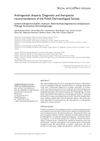22M, dutasteride + spironolactone miracle, I was losing 400-500 hairs everyday, after starting the drugs I completely stopped shedding and experienced crazy regrowth in just 3-4 months Progress Pictures 7/12/2025
A 22-year-old male experienced significant hair regrowth and stopped shedding after using dutasteride and spironolactone for 3-4 months. Spironolactone is discussed as an antiandrogen, typically used for women or transitioning individuals, and not commonly recommended for men due to potential side effects.
View this post in the Community →
Similar Community Posts Join
5 / 1000+ resultscommunity 4 years; fin 1mg/day @ 4 years; minox twice daily @ 3 years; estradiol 5mg/day @ 3 months; spiro 100 mg /day @ 3 months (Wet hair because it's easy to hide issues with dry hair)
The user shared their 4-year hair regrowth progress using finasteride, minoxidil, estradiol, and spironolactone. They noted significant regrowth by the second year and additional benefits from estradiol and spironolactone.
community Well… I Did It. Estrogen Saved My Hairline
OP transitioned and used Spironolactone, Estradiol Valerate, Minoxidil, and dermarolling, resulting in significant hair regrowth. They advise this method may not be suitable for cis men.
community (MTF 35) Results of 18 Months of HRT
A transgender woman experienced significant hair regrowth after 18 months of hormone replacement therapy (HRT) with estrogen and bicalutamide. The discussion notes HRT's effectiveness for hair regrowth but warns against its use for cisgender men due to feminizing effects.
community Insane MTF recovery 18 months blocking androgens
Hair loss recovery using estrogen and anti-androgen treatment for 18 months showed significant improvement. However, results vary and alternative treatments like RU58841 and Dutasteride may work without systemic feminization.

community Compressed part of research of theory of androgenic/anabolitic balance. AGA h-responders analytic. Theory of physio-metabolitic method of anti AGA treatment
The treatment for androgenetic alopecia involves using finasteride and minoxidil with intense exercise and cold exposure to boost metabolism and reduce androgenic effects, potentially leading to hair regrowth. This approach may activate biological pathways for improved hair and overall health.
Related Research
6 / 1000+ results
research Sulfotransferase SULT1A1 Activity in Hair Follicle: A Prognostic Marker of Response to Minoxidil Treatment in Androgenetic Alopecia
Sulfotransferase SULT1A1 activity may predict minoxidil treatment success for hair loss.

research Comprehensive Review on Hair Loss and Restorative Techniques: Advances in Diagnostic, Artistry, and Surgical Innovation
Advancements in diagnostics, treatments, and technology have improved hair loss detection and restoration, with some types being reversible.

research Androgenetic Alopecia: Diagnostic and Therapeutic Recommendations of the Polish Dermatological Society
Use trichoscopy to diagnose hair loss; treat with minoxidil, finasteride, or dutasteride; consider platelet-rich plasma and spironolactone.

research Medical Treatments for Male and Female Pattern Hair Loss
Minoxidil and finasteride treat hair loss in men, while minoxidil treats hair loss in women.

research Efficacy and Safety of Bicalutamide in Female Hair Loss: A Review of the Literature
Bicalutamide can reduce female pattern hair loss, especially in those with certain conditions, but has limited effects on other hair loss types.

research Innovative Use of Spironolactone as an Antiandrogen in the Treatment of Female Pattern Hair Loss
Spironolactone helps regrow hair in women with hair loss.